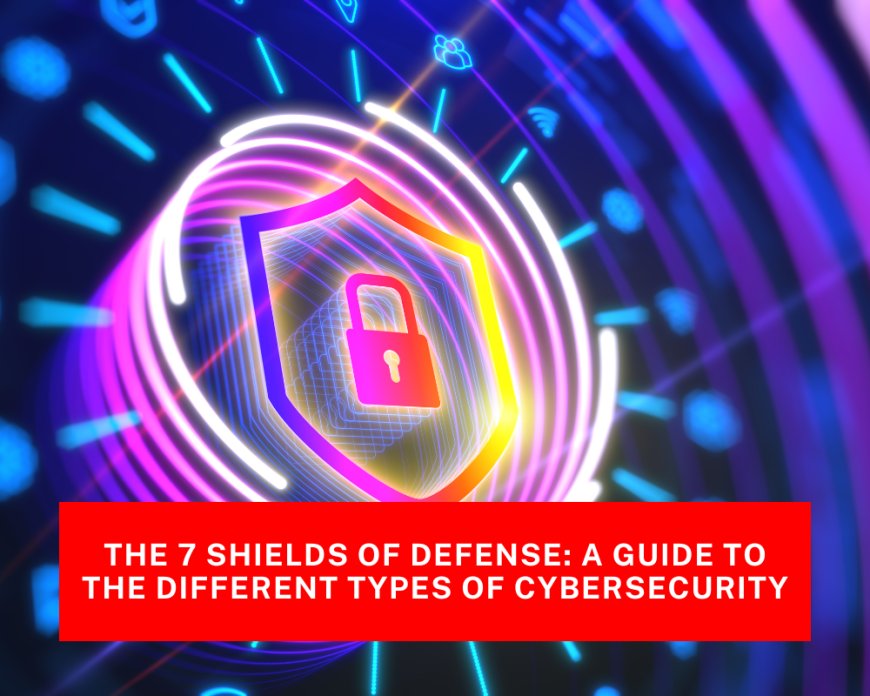The 7 Shields of Defense: A Guide to the Different Types of Cybersecurity
Dive deep into the 7 crucial types of cybersecurity: Network, Endpoint, Information, Cloud, Application, Operational, and Mobile Security. Learn how they work together to shield your data!

The digital landscape offers a wealth of opportunities, but it also comes with inherent risks. Cybersecurity, the shield protecting our digital assets, encompasses various specialized areas working in tandem to ensure a secure online environment. Understanding these different types of cybersecurity is crucial for both individuals and organizations.
1. Network Security: The First Line of Defense
Imagine a castle wall, the first barrier against invaders. Network security plays a similar role. It focuses on safeguarding computer networks from unauthorized access, intrusion attempts, and malicious attacks. Here are some key network security components:
- Firewalls: These act as digital gatekeepers, filtering incoming and outgoing traffic based on predetermined security rules.
- Intrusion Detection and Prevention Systems (IDS/IPS): These systems continuously monitor network activity for suspicious behavior and can either detect or actively block potential threats.
- Virtual Private Networks (VPNs): VPNs create secure, encrypted tunnels for data transmission over public networks, like using a secret passage within the castle walls.
2. Endpoint Security: Protecting Individual Devices
Just as every soldier in an army needs armor, endpoint security safeguards individual devices like laptops, smartphones, tablets, and servers. This type of security focuses on protecting these endpoints from malware, unauthorized access, and data breaches. Common endpoint security solutions include:
- Antivirus and Anti-malware Software: These programs scan devices for malicious software and prevent them from infecting the system.
- Data Encryption: Encrypting data renders it unreadable to unauthorized users, adding an extra layer of protection.
- Application Whitelisting: This technique allows only authorized applications to run on a device, minimizing the risk of malware infections.
3. Information Security: Protecting the Crown Jewels – Your Data
Data is the lifeblood of the digital age, and information security focuses on protecting its confidentiality, integrity, and availability. This encompasses various practices like:
- Data Classification: Classifying data based on its sensitivity – high-value data requiring stricter security measures.
- Access Control: Implementing controls that determine who can access specific data and what they can do with it.
- Data Loss Prevention (DLP): DLP solutions prevent confidential information from being leaked unintentionally or maliciously.
4. Cloud Security: Securing the Digital Sky
Cloud computing offers flexibility and scalability, but it also introduces new security concerns. Cloud security focuses on safeguarding data and applications stored in cloud environments. Here are some key aspects:
- Shared Responsibility Model: While cloud providers offer baseline security measures, organizations using the cloud also have security responsibilities.
- Data Encryption: Encrypting data at rest and in transit ensures its confidentiality even within the cloud environment.
- Identity and Access Management (IAM): Implementing robust IAM practices within the cloud controls access to resources and data.
5. Application Security: Fortifying the Gates
Applications are the gateways to our data, and application security focuses on protecting them from vulnerabilities that could be exploited by attackers. This involves:
- Secure Coding Practices: Developers following secure coding principles can minimize vulnerabilities within applications from the beginning.
- Security Testing: Regularly testing applications for vulnerabilities helps identify and address security weaknesses before they can be exploited.
- Web Application Firewalls (WAFs): These firewalls specifically focus on protecting web applications from common threats like SQL injection attacks.
6. Operational Security (OpSec): Building a Culture of Security
OpSec goes beyond technical measures and focuses on establishing procedures and practices that promote overall security awareness within an organization. This includes:
- Security Policies and Procedures: Clearly defined policies outlining acceptable security practices and employee responsibilities.
- Employee Training: Regular training programs educate employees about cybersecurity threats and best practices.
- Incident Response Planning: Having a plan in place to deal with security incidents effectively minimizes damage and recovery time.
7. Mobile Security: Protecting On-the-Go Devices
With the growing prevalence of mobile devices accessing sensitive data, mobile security has become critical. This type of security focuses on protecting smartphones, tablets, and other mobile devices from various threats:
- Mobile Device Management (MDM): MDM solutions allow organizations to manage and secure mobile devices used by employees.
- App Vetting: Implementing a process to vet and approve mobile apps before allowing them on employee devices.
- Strong Passwords and Encryption: Encouraging strong passwords and data encryption on mobile devices provides a vital layer of defense.
Conclusion: A United Front for a Secure Digital World
These seven types of cybersecurity work together to create a comprehensive defense system. Just like a well-fortified castle, a robust cybersecurity strategy requires a multi-layered approach. By understanding these different types and implementing appropriate controls, individuals and organizations can significantly enhance their online security posture. Here are some additional takeaways:
- Continuous Vigilance is Key: The cybersecurity landscape is constantly evolving, so staying informed about new threats and updating security measures is crucial.
- A Shared Responsibility: Both individuals and organizations have a role to play in maintaining a secure digital environment.
- Prioritizing Security: Investing in robust cybersecurity measures might seem like an expense, but the cost of a cyberattack can be far greater.
By prioritizing cybersecurity and embracing these different areas of protection, we can build a more secure digital world. Whether you're an individual safeguarding your personal data or an organization protecting valuable assets, understanding the different shields of cybersecurity empowers you to navigate the digital landscape with confidence.








